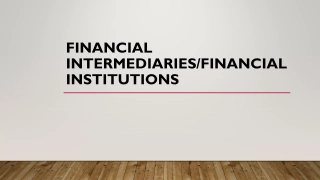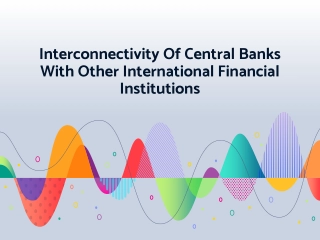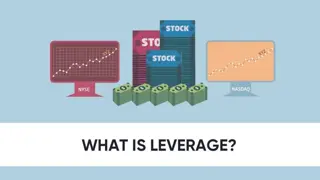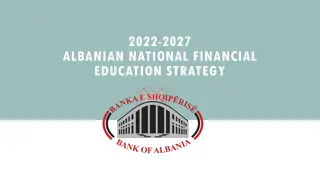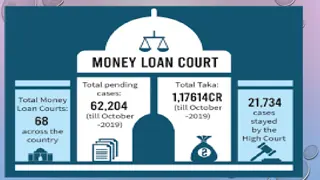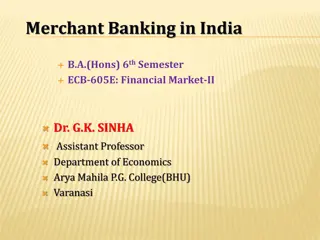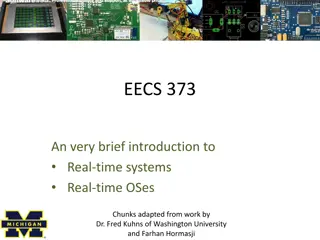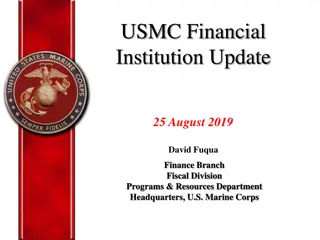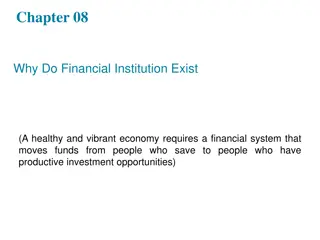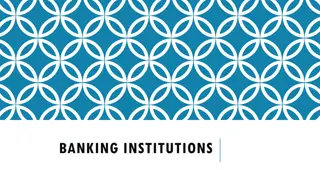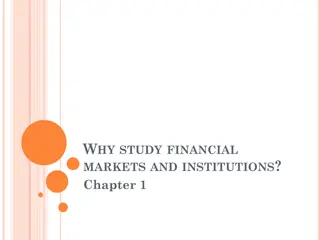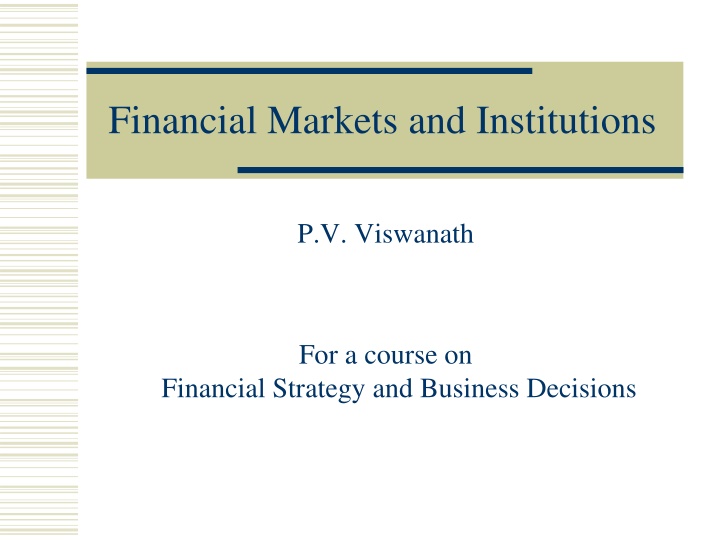
Financial Markets and Institutions in Business Decisions
Explore the world of finance through the lens of financial markets, institutions, and the flow of funds. Learn about the role of surplus and deficit units, financial intermediaries, and the functioning of commercial banks. Discover how funds are transferred and allocated in the financial system to support businesses and individuals.
Download Presentation

Please find below an Image/Link to download the presentation.
The content on the website is provided AS IS for your information and personal use only. It may not be sold, licensed, or shared on other websites without obtaining consent from the author. If you encounter any issues during the download, it is possible that the publisher has removed the file from their server.
You are allowed to download the files provided on this website for personal or commercial use, subject to the condition that they are used lawfully. All files are the property of their respective owners.
The content on the website is provided AS IS for your information and personal use only. It may not be sold, licensed, or shared on other websites without obtaining consent from the author.
E N D
Presentation Transcript
Financial Markets and Institutions P.V. Viswanath For a course on Financial Strategy and Business Decisions
What is Finance Finance is the study of how people allocate scarce resources over time. Decisions are made across time Decisions are made in an environment of uncertainty Decisions are made in the context of a financial system P.V. Viswanath 2
Financial System The financial system is the set of markets and other institutions used for financial contracting and the exchange of assets and risks Markets for stocks, bonds and other financial instruments Financial intermediaries such as banks and insurance companies The regulatory bodies that govern all of these institutions, such as the Federal Reserve, the Securities and Exchange Commission etc. P.V. Viswanath 3
Flow of Funds The financial system allows for the transfer of funds from surplus units (such as savers) that have excess resources to deficit units, such as businesses that need resources. This can happen either through the market, as when an individual uses his savings to buy shares issued by a corporation. Or through intermediaries, as when an individual deposits money in his banking account, and the bank then lends this money to a firm. P.V. Viswanath 4
Financial System: Flow of Funds Markets Surplus Units Deficit Units Intermediaries P.V. Viswanath 5
Surplus or Deficit Are Corporations Surplus Units or Deficit Units? Deficit Units Surplus Units Both P.V. Viswanath 6
Examples of Financial Intermediaries Commercial Banks Insurance Companies Pension and Retirement Funds Mutual Funds Investment Banks Venture Capital Firms Asset Management Firms Information Service Providers P.V. Viswanath 7
Commercial Banks These are financial intermediaries that offer checking accounts, savings accounts, money market accounts and accepts time deposits. They also facilitate payments by way of telegraphic transfer, electronic funds transfer, internet banking, or other means. They make loans to businesses and consumers. They also buy corporate and government bonds. P.V. Viswanath 8
Investment Banks An investment bank is a financial institution that raises capital and advises regarding such matters, advises regarding and sells corporate insurance products like credit default swaps, trades securities and manages corporate mergers and acquisitions. It may also have a wing that does research on the prospects of companies. Some investment banks are also involved in private equity, where the bank invests its own capital. In contrast to commercial banks that deal with individuals, investment banks tend to work with corporations and governments. P.V. Viswanath 9
Venture Capital Firms Venture Capital is a type of private equity capital typically provided for early-stage, high-potential, growth companies in the interest of generating a return through an eventual realization event such as an IPO or trade sale of the company. Venture capital investments are generally made as cash in exchange for shares in the invested company. For ventures that need financing at earlier, more speculative, stages of the business, angel financing is more appropriate. Part of this information was taken from Wikipedia P.V. Viswanath 10
Asset Management Companies These include hedge funds and other mutual funds. Typically, they invest in existing securities, as opposed to investing directly in companies. For example, Bardin Hill uses portfolio risk managers and independent risk analysts and engages in research across capital structures, regions, and business/economic cycles; It uses both a Bottom-Up and Top-Down Investment method Individual position comparison based on risk/reward analysis Structures portfolios and allocate capital among strategies Uses attribution analysis for macro decision making and planning P.V. Viswanath 11
Regulatory Institutions Central Banks SEC, FASB and other institutions that regulate financial intermediaries or financial markets International Co-ordinating Organizations World Bank to promote international development International Monetary Fund to promote international trade and finance. Bank for International Settlements to promote uniformity of banking regulations P.V. Viswanath 12
Investment Bank Is an Investment Bank a Bank? Yes No P.V. Viswanath 13
The Financial System: Its Functions To transfer economic resources across time, borders and among industries To provide ways of managing risk To provide ways of clearing and settling payments to facilitate trade To provide a mechanism for the pooling of resources and for the subdividing of ownership in various enterprises P.V. Viswanath 14
The Financial System: Its Functions To provide price information to help coordinate decentralized decision making in various sectors of the economy To provide ways of dealing with the incentive problems created when one party to a transaction has information that the other party does not or when one party acts as an agent for another P.V. Viswanath 15
Transferring Economic Resources Intertemporal Borrowing and lending are ways of transferring resources across time Across space (or cyberspace) If you have money in your checking account and you can access this via your Debit Card at your local store, this is transferring resources across space If investment banks collect financial resources in the US and invest it in developing countries like China or India, this is also a transfer of resources across space P.V. Viswanath 16
Managing Risk Issuing shares in their firms is a way for entrepreneurs to share the risk of the enterprise with others. Futures contracts represent a way of offsetting risk It is possible to buy insurance to lay off risk CDOs (Collateralized Debt Obligations) represent complex ways of distributing risk Credit swaps are another example of transferring firm-specific default risk. P.V. Viswanath 17
Clearing and Settling Payments Every time we write a check or use a credit card, we use the payment facilitation function of the financial system. When you buy shares through your broker, this is done through the Stock Exchange which brings buyers and sellers together. However, there is a clearing house, which actually facilitates the exchange of money for the shares. Most electronic funds transfers involving international transactions take place through the Clearing House Interbank Payments System (CHIPS), a computerized network developed by the New York Clearing House Association. Most large US banks and US branches of foreign banks are members of CHIPS. P.V. Viswanath 18
CHIPS: Interbank Clearing System https://www.theclearinghouse.org/payment-systems/- /media/4143b0e4c558457491e053ae652fcbc9.svg P.V. Viswanath 19
Credit Cards Credit Card Transaction Example: $100 purchase by consumer using Visa or MasterCard $2 discount fee charged to merchant by acquirer/processor includes: $1.50 interchange fee paid to card issuer $0.10 assessment fee paid to card association (Visa/MasterCard) $0.40 merchant processor fee $98 credited to merchant for the transaction P.V. Viswanath 20
Credit Card Transaction Process Automated Clearing House From: Ramon P DeGennaro. Merchant Acquirers and Payment Card Processors: A Look inside the Black Box, Economic Review - Federal Reserve Bank of Atlanta. Atlanta: First Quarter 2006. Vol. 91, Iss. 1; pp. 27-43. P.V. Viswanath 21
Credit Cards: The Players Merchant Processor: Performs credit check on merchant, sells or leases a terminal, establishes a connection between merchant and the Credit Card processor Credit Card Association: Establishes rules and guidelines for card issuance and acceptance, markets brand name and various products. North American Credit Card Association is one such association. Visa, MasterCard, Discover, China UnionPay and American Express are also credit card associations that set transaction terms for merchants, card- issuing banks, and acquiring banks. Acquiring Bank: A bank or financial institution that processes credit or debt card payments on behalf of a merchant. P.V. Viswanath 22
Credit Cards: The Players Card Issuer: Establishes criteria to approve or deny applicants and sets credit limits, interests rates, and fees. Ultimate risk taker. These are the actual issuers, e.g. Discover, Capital One, Barclays, Chase and many other banks issue credit cards. Credit Card Processor: Receives and processes credit card applications, maintains cardholder data. Visa, MasterCard, Discover and American Express process payments. Discover and American Express issue credit cards as well. Clearing House: ACH is a computer-based clearing and settlement facility established to process the exchange of electronic transactions between participating depository institutions. Settlement for a credit card transaction is triggered when the acquiring bank deposits the funds into the merchant s account. P.V. Viswanath 23
Pooling Resources/Subdividing Shares Mutual Funds provide a way for investors to come together and buy larger amounts of securities in an efficient manner The corporate form of organization allows individuals to own parts of enterprises Limited Partnerships allow individuals to participate in business enterprises and reap tax and other benefits ETFs are a way of trading baskets of securities simultaneously. P.V. Viswanath 24
Funds and Movie Investing Barbarian Film Investment Fund, a $150 million structured fund A mitigated-risk portfolio of non-correlated assets Invests only in independent films that have greater than 80% of their budgets secured by foreign pre-sales. Invests only in relatively low-budget films costing less than $10 million Investment opportunities will be vetted by international sales agents who will make foreign sales estimates based on such factors as the film's genre, cast and creative team. The first film backed by the fund, "Powder Blue," starring Forrest Whitaker, Jessica Biel and Jared Leto, began shooting in August 2007; it has a budget of $5 million with foreign sales estimated at $4.15 million. P.V. Viswanath 25
Film Funds: S&R Films Movie finance is at the core of S&R s business. S&R Films controls a film fund of private equity and has been investing in feature length motion pictures since 2011. In order for a film to be considered for equity film financing, the movie or production must exhibit inherent mitigated risk by having secured assets that outweigh the total budget based on current marketplace trends. Such qualifying assets include bankable name talent, bankable name directors, and presales or minimum guarantees on limited territories where such presale values indicate a robust potential profit margin on remaining territories for the film s equity tranche. http://snrfilms.com/film-financing/ P.V. Viswanath 26
Types of financial markets Equity Markets Fixed Income markets Money market Long-term capital market for debt securities Derivatives Options Forwards Futures P.V. Viswanath 27
Rates of Return Fixed Income Securities have promised rates of return. Thus, a bond might pay 8% per annum, i.e. for every $100 lent, the investor receives $8 per year. However, the borrower might not be able to pay the promised annual return or the principal. Hence the actual return could be less than the promised return. If an investor buys a bond for $100 on Jan. 1 and receives interest of $8 on Dec. 31. Suppose on Dec. 31, the bond drops in value to $98 because investors believe that the likelihood of the investor paying off the bond in full is less than certain. The actual return on the bond over the year is [8+(98- 100)]/100 = 6% P.V. Viswanath 28
Nominal and Real Rates of Return Suppose an investor buys a bond for $100 on Jan. 1 and receives $8 on Dec. 31. Suppose the price of the bond on Dec. 31 remains at $100. The nominal return on the bond is 8/100 or 8%. Suppose, however, that prices have risen 3%; i.e. a basket of goods that cost $100 at the beginning of the year costs $103 at the end of the year. The investor has given up one basket of goods at the beginning of the year for (100+8)/103 = 1.0485 baskets of goods at the end of the year. The real rate of return on the bond is 4.85% P.V. Viswanath 29
Expected Rates of Return Prices of traded assets are set according to the return that investors expect to get on average on their investments. If an asset is expected to be worth $120 at the end of the year, and no cash distributions are expected, then an investor desiring an expected return of $12% will pay 120/1.12 or $107.14 for the asset at the beginning of the year. (120 107.14)/107.14 = 12% P.V. Viswanath 30
Determinants of Expected Rates of Return The expected productivity of capital goods Capital goods, such as mines, roads, factories are more productive if an initial investment returns in more output at the end of the period The degree of uncertainty about the productivity of capital goods Investors dislike uncertainty; the greater the uncertainty, the greater the required expected rate of return Time Preferences of people If people dislike waiting to consume, expected returns will be higher. Risk Aversion The more people dislike uncertainty, the greater the required expected rate of return Expected Inflation The higher the expected rate of inflation, the greater the required expected nominal rate of return P.V. Viswanath 31
Information Problems and Finance Prices of financial assets are very important in sending the right signals to economic agents making real investment decisions. We now talk about information-related issues: The role of the financial sector in providing information When might this role might be inefficiently performed Adverse Selection Moral Hazard Principal-Agent problems P.V. Viswanath 32
Providing Information Asset prices and interest rates provide critical signals to firm managers in their selection of investment projects. If a manager notes that stock prices are up in a certain sector, that is indicative of higher profits in that sector. It is, therefore, worthwhile investing there. Should a firm finance its projects in dollars or in euros? It can look at the forward euro rate, as well as euro-denominated interest rates to figure out the cost of borrowing in euros. It can look at borrowing rates domestically If the implied euro borrowing rate is lower, this means that there are more investors with euro resources and its better to finance in euros. Individuals can also use interest rates as a guide to decide how much they want to save and how much to consume today. P.V. Viswanath 33
Information and Action It is worthwhile mentioning that, while higher stock prices in a given industry could be taken to imply the need for more real investment in that industry, it does not mean further investment in traded financial securities in that industry is warranted. Financial securities markets are fairly liquid and informationally efficient; hence prices adjust pretty rapidly to information. Good news about a stock or industry will cause that information to cause the stock price to rise pretty quickly (perhaps within seconds), and beyond that window, will not imply abnormal returns for any investor. Furthermore, the supply of financial securities is pretty fixed and cannot be easily increased in the short run. P.V. Viswanath 34
Information and Action: 2 On the other hand, if the reason for the increase in stock prices is due to an excess of demand over supply in that industry, real investment devoted to increasing supply of the underlying product will result in gains for the real sector investor. The reason is that real investment cannot occur instantaneously and there is a larger window within which such investment can be profitably made. Furthermore, not everybody has the resources/knowhow to undertake real investment in a given sector . It is, of course, still true that if a potential real investor waits too long, such delayed investment will not be profitable. P.V. Viswanath 35
Markets and Information In 1987, the stock market crashed. Many people think this was because investors had synthesized put options to allow themselves to pull out of the stock market if prices dropped. A put option is a security that allows the holder to sell an underlying asset at a pre-specified price this provides the holder with a floor value for the asset. Synthetic put options work by sending electronic signals to trading programs to sell automatically if prices drop. A synthetic put option only works if the sell is executed. In 1987, investors thought that they had price floor because of these synthetic put options. However, since these put options were not traded, investors did not know how many investors were planning on executing the same sell strategy. P.V. Viswanath 36
Markets and Information When stock prices dropped, all these programs tried to sell simultaneously. However, there were many more sellers than buyers and most sellers were not able to sell at the prices that they had planned to. Prices plummeted, triggering fresh program selling. Ultimately, the floor that investors thought they had, didn t exist because they didn t have the information they needed to evaluate the feasibility of the synthetic put strategy. The introduction of index options allowed investors to obtain information on the supply and demand for such options, as well as a more straightforward way of buying put insurance. P.V. Viswanath 37
Other Providers of Information We have seen that markets act as aggregators of individual pieces of private information and incorporate them in prices, so that resource allocation decisions can be taken. In addition, individual firms collect information already available (but not necessarily easily), either about prices or about other aspects of firms so that individuals can make decisions. For example, Bloomberg, Factset, Compustat and other such organizations provide firm and market information through their own databases. Some firms might create new information by taking existing information, analyzing them and then presenting them in more useful ways for investors to make decision. Credit Rating Agencies like Fitch and Moody s would fall in this category. So would equity research shops like JP Morgan, Goldman Sachs etc. P.V. Viswanath 38
Adverse Selection Adverse selection: One of the parties to a transaction lacks information while negotiating. An example of adverse selection is when people who are high risk are more likely to buy insurance, because the insurance company cannot effectively discriminate against them, usually due to lack of information about the particular individual's risk but also sometimes by force of law or other constraints. P.V. Viswanath 39
Adverse Selection Suppose you announce that you are in the market for a used car and your budget is around $20,000 Suppose you can only tell imprecisely the true value of a car that is offered to you. What proportion of cars offered to you will have an (unobservable to you) true worth of more than $20,000? More than half Less than half Exactly half P.V. Viswanath 40
Adverse Selection Because of asymmetry between insider firm managers and outsider investors in financial markets, stock prices are likely to be sometimes too high and sometimes too low. Just like in the used car market, overvalued firms are more likely to issue stock to take advantage of the overvaluation. Hence, ceteris paribus, an announcement by a firm that it is selling stock can be a revelation to the market that it is overvalued. Empirical evidence shows that stock prices, on average, drop on the announcement date. P.V. Viswanath 41
Moral Hazard Moral hazard: The ignorant party lacks information about performance of the agreed-upon transaction or lacks the ability to retaliate for a breach of the agreement. People are more likely to behave recklessly if insured, either because the insurer cannot observe this behavior or cannot effectively retaliate against it, for example by failing to renew the insurance. This is an example of moral hazard. Both issues are incentive problems and both have to do with lack of information; adverse selection manifests itself prior to the contract and moral hazard subsequent to the contract. P.V. Viswanath 42
Moral Hazard Suppose 50% of drivers are good drivers and 50% of drivers are bad drivers. Also, suppose an insurance company cannot tell good drivers from bad drivers. The insurance company offers an automobile insurance policy. What proportion of its policy holders will turn out to be good drivers? Half More than half Less than half P.V. Viswanath 43
Moral Hazard What moral hazard problem is induced by the Federal Reserve bailing out banks? Is there a moral hazard problem when the Federal Government helps people affected by Hurricane Maria or Hurricane Katrina? Is there a moral hazard problem when the government helps people who can t make their mortgage payments because they have lost their jobs? Arguably, there is a moral hazard problem because people figure that the government is compelled politically to help them in difficult situations. As a result, they take excessive risk. How would you deal with these situations? P.V. Viswanath 44
Principal-Agent Problems Principal-Agent problem: A special case of the moral hazard problem is when one party (the agent) undertakes to act on behalf of the other (principal). However, if the agent cannot be costlessly monitored, s/he might act in his own interests and to the detriment of the principal. An example is when managers might act too conservatively because they don t want to lose their jobs if the business fails and they turn down risky, but profitable investment opportunities P.V. Viswanath 45
Moral hazard between managers and bondholders Bondholders lend money to a firm and rely upon the firm s managers to make good investment decisions so as to be able to repay bonds when they come due. However because bond payments are capped, firm managers have an incentive to take excess risk. If the result of the risky investment is good, the returns above the cap go to the firm. If the result of the risky investment is bad, the bond holders don t get paid; since stock holders are not first claimants, the impact on them is less. P.V. Viswanath 46
Financial System Solutions Adverse Selection Banks cultivate long-term relationships with their clients making it less risky for clients to share sensitive information with the banks and allowing banks to price risk in a more informed fashion. There is evidence that the bond prices of firms that take loans from reputable banks go up! Firms can signal using mechanisms such as dividends and capital structure to reduce the adverse selection problem in the sale of securities. Firms can signal quality through the offering of guarantees; this reduces the adverse selection problem in the sale of products/services. P.V. Viswanath 47
Financial System Solutions Moral Hazard Managers could be given shares of stock or stock options to give them incentives to act like stockholders. Collateralization of loans reduces the incentive for borrowers to act in a risky fashion since they would lose their collateral. The existence of liquid markets for collateral then allows lenders to dispose of the collateral. Markets for collateralized assets also allow them to keep track of the value of the collateral. P.V. Viswanath 48
Financial vs Operating Decisions Decisions that the firm s managers have to take can be divided broadly into financing and operating decisions. Investment/Operating Decisions relating to allocating resources Financial How to pay for operations and expansion and what to do with excess cash. P.V. Viswanath 49
Strategic and tactical financial decisions Financial decisions that have implications for future operating decisions are called strategic financial decisions. Because of this connection, such actions need to be coordinated. Coordination is important because often these decisions are made by different areas of the firms and by different managers. The same financial decision can sometimes be strategic and sometimes non-strategic or tactical. For example, if a manager decides to invest in real estate, an issue of long- term bonds to raise funds for this investment is a tactical decision. However, an issue of bonds intended to increase leverage as a means to communicating an aggressive stance to competitors is a strategic financial decision. Finally, the same decision can have both strategic and tactical implications. In this course, we focus on the implications of financial decisions for subsequent operating decisions. P.V. Viswanath 50

